Have you met a terrible fate?
Where you spend all your time fielding varied requests from across the company, many of which you shouldn’t be responsible for? Or are you a PDF factory just churning out product material that sits in the company GDrive collecting dust?
Or my personal favorite — the glorified project manager. Simply moving a bunch of stuff along without making any decisions or strategic impact.
Product marketing is barely consistent within our own ranks, and much less understood across departments in software. The varied responsibilities and confusion often leads to these fates and frustrated product marketers.
Our best tool to nip this in the bud is expectation setting, typically in the form of charters, which is a fancy way to say documentation that explains what the heck we do.
Charters are an important tool whenever you are starting a new gig or have an opportunity to reset (could be beginning of a quarter or year as an example). They give us the power to dictate our responsibilities and clarify our value.
That’s why I created a Product Marketing Charter first thing when I joined UserEvidence. It’s not just a document; it’s a survival guide and a statement of purpose. It outlines what we do, why we matter, and—critically—what people can expect from us.
But hey, don’t feel like you have to take it from me. Here’s what our co-founder, Ray, had to say about my charter:
My charter was critical in building product marketing from scratch here, so today I’m going to share everything about it with you with the goal of helping you create your own. We’ll go through:
- How to structure your charter—What to include and why
- My actual charter deck I presented to our team, with a full slide-by-slide breakdown so you can steal my best ideas and improve on my worst
- What happened when I re-visited the charter six months into the gig
Here’s my charter. Give it a look then keep reading:
Product Marketing @ UserEvidence (Shared)
How to structure your PMM charter
Think of your charter as a pre-read for working with you and your team. Everything should be done in service to your goals which are not just to clarify what your role is, but to dictate what you are responsible for and what your cross-functional partners can expect from you.
If you’re starting at a new company you should’ve covered role focus and needs during the interview process. The charter will build off of that and make it tangible for the rest of the company. The initial problems I tackled at UserEvidence and projects listed in my deck were all discussed during my hiring.
If you’re in an existing role and trying to reset expectations, you should first create your charter as a presentation for leadership to sell them on why product marketing needs to change in your company. (You won’t see that in my charter deck since it was for a new role.) Get your pitching hat on and be prepared to come ready for tough conversations about what isn’t working, your proposed changes, and the numbers to back it all up. My CEO, Evan, after seeing my charter, agreed.
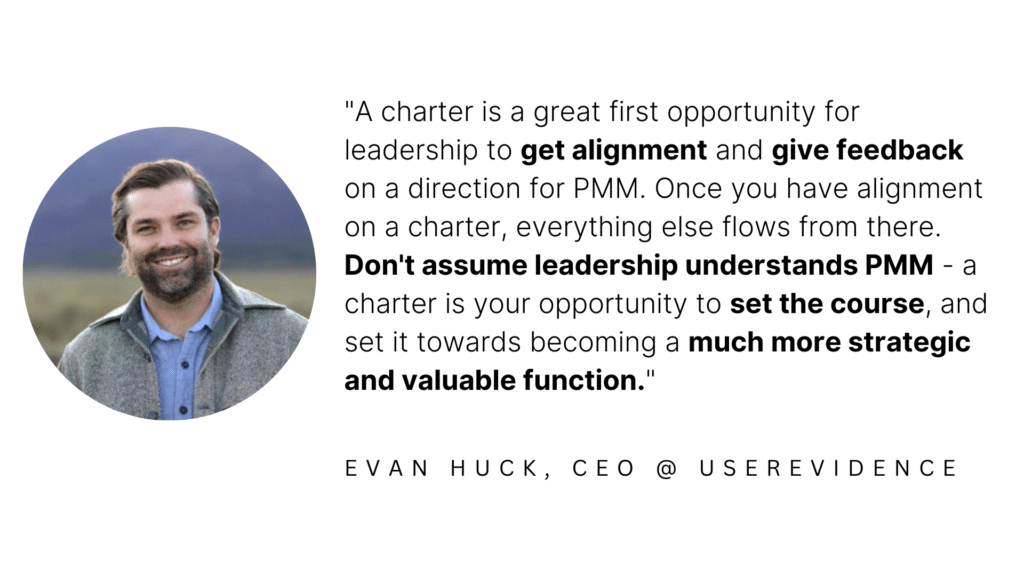
After getting leadership buy-in you can take out portions from the leadership conversation that aren’t necessary for the rest of the company and use the core structure below as-is.
My charter covered four key areas:
- What is product marketing? A baseline vision & definition. (Slides 1-9)
Including a full definition of product marketing right off the bat addresses the elephant in the room. What can product marketing do? What does good product marketing look like? This is your opportunity to create a vision for your role and sets the stage for when you whittle it down to actual responsibilities. - What is product marketing at UserEvidence? (Slides 10-15) Here you’ll get specific for your role. Start with the core business problems you’ll be tackling and areas of focus, then get tactical with a list of initial projects. This part of the presentation will look very different depending on the company. I’ll call out those possible differences when I walk through it below.
- When to come to PMM and when not to (Slide 16)
I created a checklist for the team to show what I can help with and which questions I want them to come to me for. While I didn’t include a don’t list in mine, it’s a good idea for larger, more specialized teams or if you’re resetting expectations in an existing role. - OPTIONAL: A view into the world of product marketing (Slides 17-22)
I included extra depth on product marketing to help our team understand our buyer. I won’t walk through this section in-depth here but you can see it in the deck. Not necessary for your charter, unless you also sell into PMM (like we do).
Every product marketing charter should include the first three areas. The fourth isn’t always necessary. I included it in mine because product marketing is one of our core users and buyers, so I basically folded some persona training into this presentation since there was a dual benefit for the team. That extra level of depth isn’t necessary otherwise.
Remember: This is internal selling. You are the expert, and your charter is you sharing your point of view. Always, always, always, explain any buzzwords and jargon. AKA–don’t throw out the terms ‘storytelling’ and ‘strategy’ and ‘go-to-market’ without defining what that means. Your team should leave the call understanding what you will do, understanding how they’ll work with you, and fired up about it.
All right, let’s walk through my charter slide by slide.
A slide-by-slide breakdown of my product marketing charter
What is product marketing? A baseline vision & definition. (Slides 1-9)
You may not need this section in its entirety. If the company has a good understanding of PMM, an understanding you approve of, then you should focus all your time on the next section (PMM for your company specifically). But I will say, in my experience folks don’t get it even if they say they do. If you’re in an established role you’re likely reading this because you’re unhappy with current expectations, so it’s time to force a fresh start. For solo PMMs, usually you’re in a younger company where folks may not have worked with PMM before, so its a good time to educate.
My approach to defining product marketing started with what good and bad looks like. I began by visualizing product marketing in a way my team could immediately understand on slide three. Using the classic PMM venn diagram from PMA, I showed product marketing’s cross-functional role and discussed how we serve each function.

I didn’t shy away from showcasing both the highs and lows of the role and how that affects the cross-functional relationship. At its best, product marketing is a strategic powerhouse driving decisions across teams. At its worst, it’s a glorified task manager, stuck coordinating projects without wielding any real influence.
The best/worst setup may not be necessary for your charter (again, remember I’m helping our broader org understand PMM and what we deal with), but it’s important for you to remember this is a part of why you’re building a charter. The ability to be a strategist and influencer vs. project manager is earned. The charter is a part of you earning that right.
To dig deeper into the role I talked about storytelling, using Paul Bettany’s brilliant performance as Geoffrey Chaucer in A Knight’s Tale as an example of great storytelling. He brought the right message to the crowd to build Sir Ulrich von Lichtenstein’s reputation up from nothing. He built the intrigue and demand. We are storytellers—crafting the narratives that define how our product is positioned, understood, and sold. I like bringing in non-B2B references and metaphors whenever possible to lighten things up and spark interest.
Oh, and I made sure to joke about speak against the fact that most of his stories were lies… can’t be perpetuating the all marketers are liars thing right?
I summarized this duality with “product marketing is strategy + story.” Strategy is the theory and story is the practice.


I ended this section with the PMA visual of different product marketing areas of impact.

This visual does a great job of showing the scope of what PMM can support whether you’re market-focused or product-focused. Depending on your team size this gives you a place to narrow down from, or a window into new areas you’d like to expand into. For solo PMMs this is way too much for one person to do, so use it to show the tradeoffs you need to make. Larger teams can split up responsibilities as we often see in the enterprise where enablement, launch, or competitive focuses are common.
For expanding your role, if you’ve been pipeline focused but are trying to turn more towards the product side, you can show this is an understood function in product marketing and an extension of your skillset. You’re backed up by an established framework from an established professional organization vs. it being simply your opinion or desires.

What is product marketing at UserEvidence? How to specify PMM at your company (Slides 10-16)
Now that the easy, fun, higher level part is over and your team understands what PMM can be, it’s time to get real. Time to show what product marketing WILL be at your company. This is the selling part, and for most readers this is where you should spend the majority of your time.
Slides 11-12 in my charter are an acknowledgement that product marketing doesn’t exist in a vacuum. At UserEvidence, our sales-led motion heavily influences my priorities. For example, I emphasized sales enablement over product adoption, given the importance of arming our sales team to close deals. I also noted that as a smaller organization, my role would cover a broader scope than it might in a larger, more specialized team.

I included more detail about our GTM motion to provide more context as to why I would be more focused on market-side activities. Different motions in a software company require different efforts (self-service vs a high touch sales process is a great example), so matching my role to our GTM motion is easy proof.
For your charter: What company or market conditions back you up? These are things the company has agreed are proof points for your approach and show you know the environment you’re operating in. This could be GTM motion, team/department makeup, and annual initiatives handed down from leadership.
After all the context I defined what I see as my three core responsibilities.
- Bring products to market
- Create demand for our product
- Help sell our products effectively.
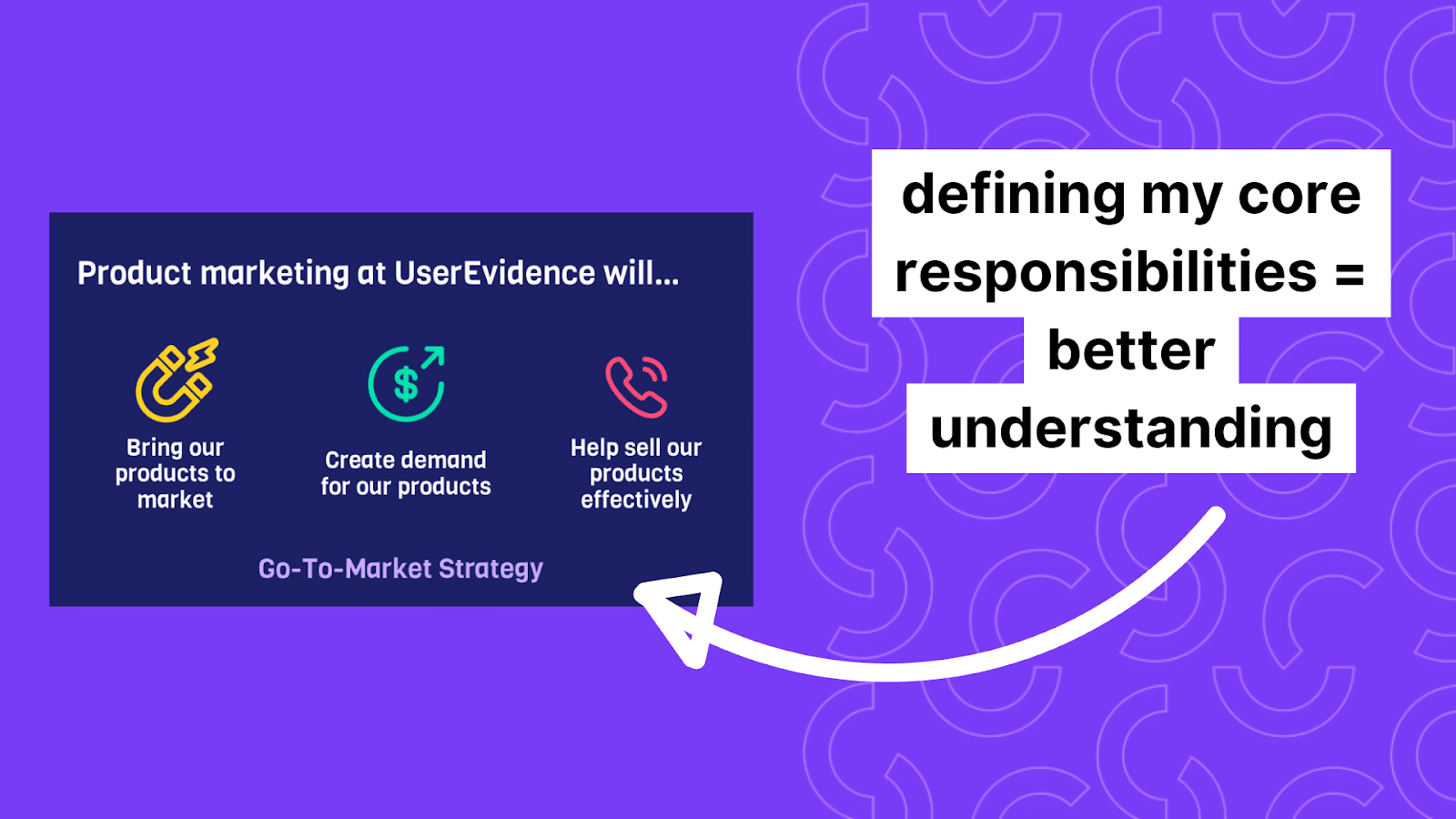
These three together I called ‘go-to-market strategy’; another term people throw around a lot that I wanted to define for our team.
Now you’ll see in action how the first parts of the presentation set me up for clarity at the end. I’ve talked about product marketing from a high level theoretical view, I’ve shared context and a wide range of possible responsibilities, and now I use the same reference points to say exactly what I’ll do.
Slide 14 brings back the PMM role map. I’ve circled my core focuses to start with the colors coded to match the 3 responsibility areas from the previous slide.
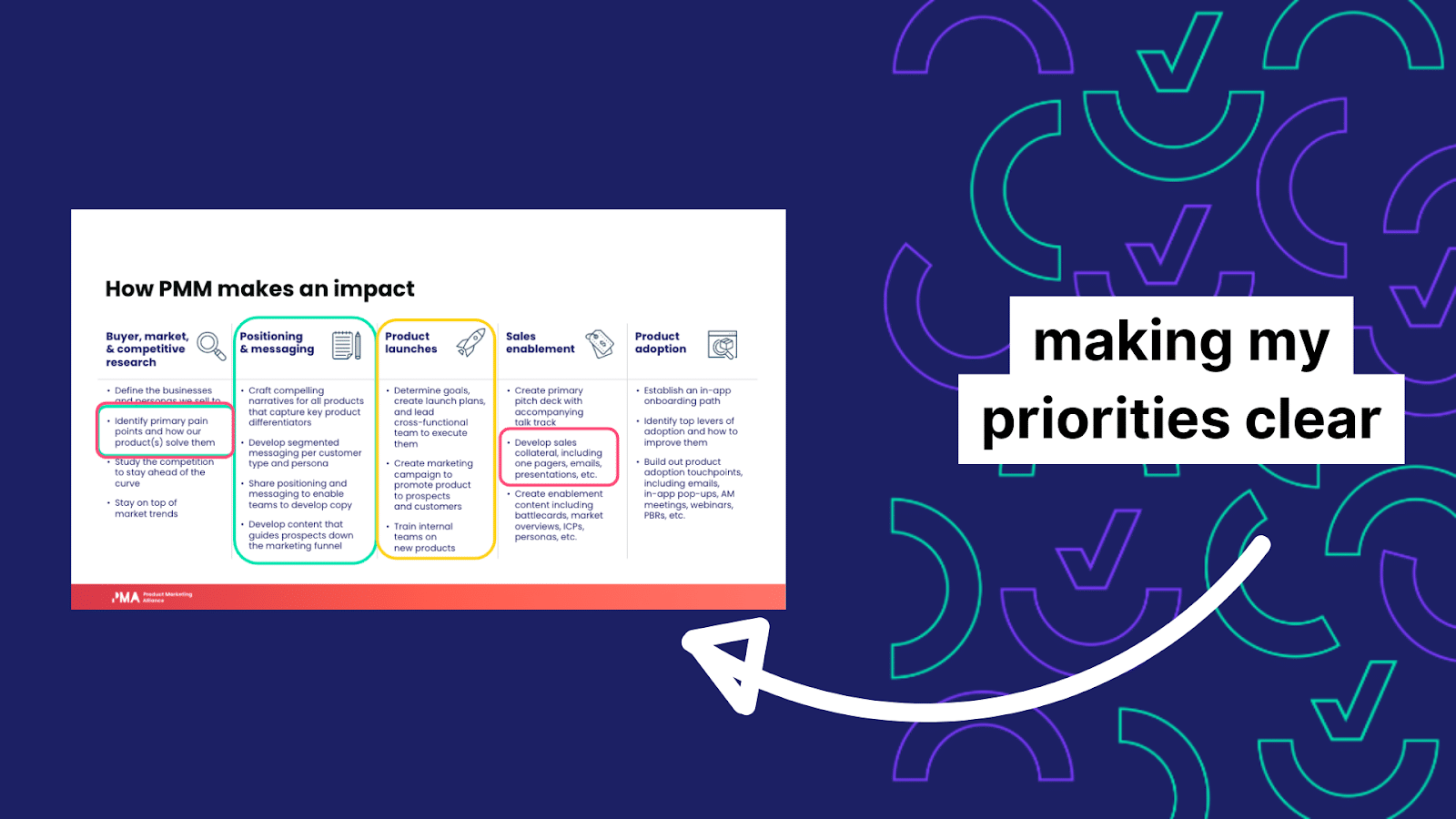
This is what I’ll do. But I took it one step further and identified 5 specific short-term projects I started with that fit into these buckets.
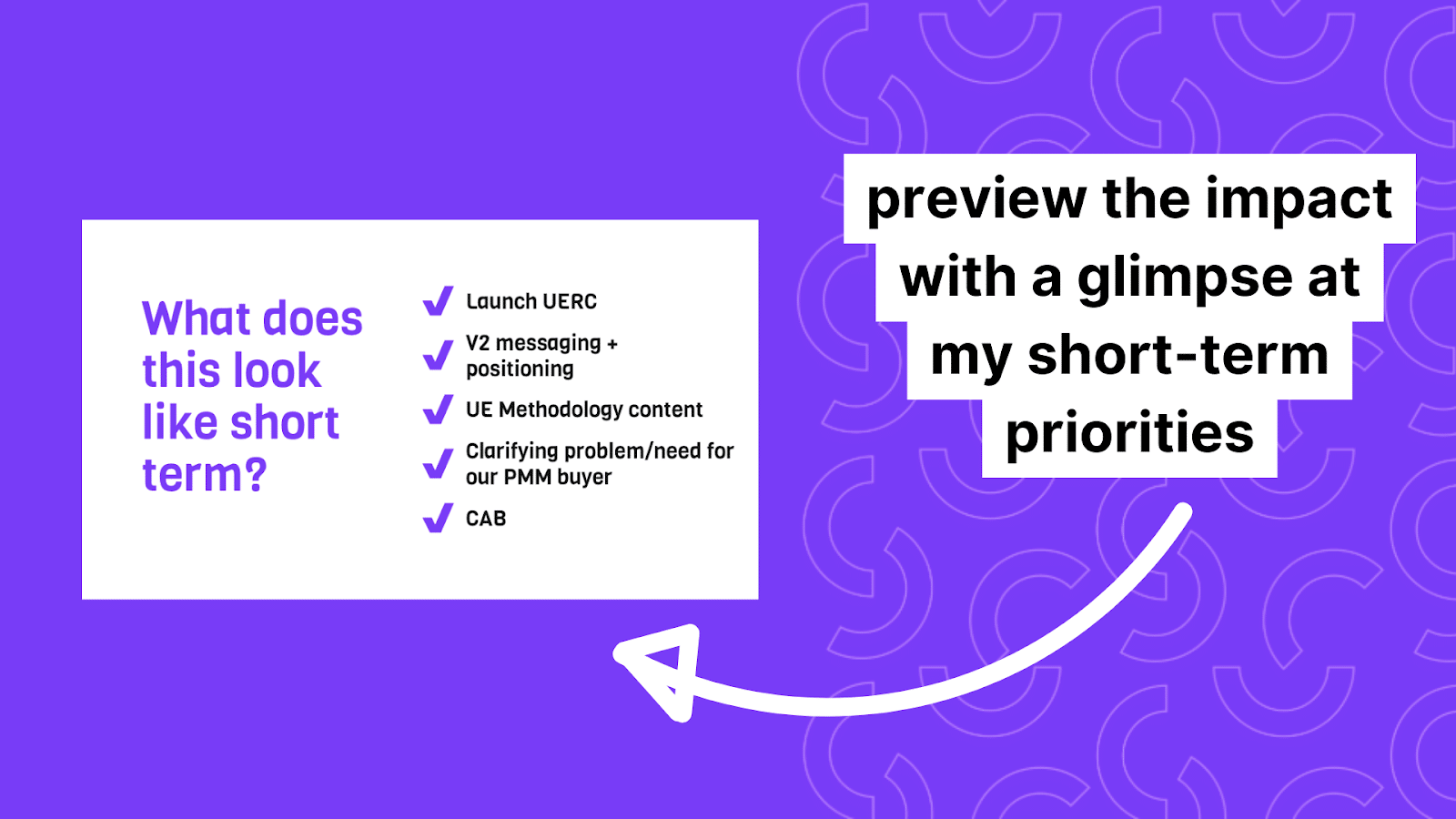
These projects were already green lit by leadership since we’d discussed everything during my interview and onboarding process. I could proceed with confidence and they backed me up with their confirmation of priorities and how these projects help move us forward. Leadership’s approval does a lot of legwork for you here. It carries more weight.
Aligning with leadership first, as I talked about in the structure section above, makes this whole process legitimate. Getting specific, shows the team exactly how you’ll jump in to help them right away and how it aligns with broader company objectives. This slide feels more real than ‘storytelling’ and ‘go-to-market strategy’ by themselves.
Note: for the broader terms on this slide I talked through specifics. For example, V2 messaging + positioning included renaming our platform to customer evidence platform, re-doing our website homepage and core product page, and training the team on an updated messaging document. Can you tell I avoid leaving generalities on their own as much as possible? Tell them exactly what you mean! If you can’t break it down then you have a different problem on your hands.
I wrapped up with the classic ‘when to come to product marketing’ list. Building off of everything I’d shared, I wanted to anchor some areas of operation where I want them to think of product marketing. I don’t think any of these will be surprising to you, but since it was at the end I made sure to talk through why I’m qualified to help with these areas and how they fit into the work I’ll be doing.
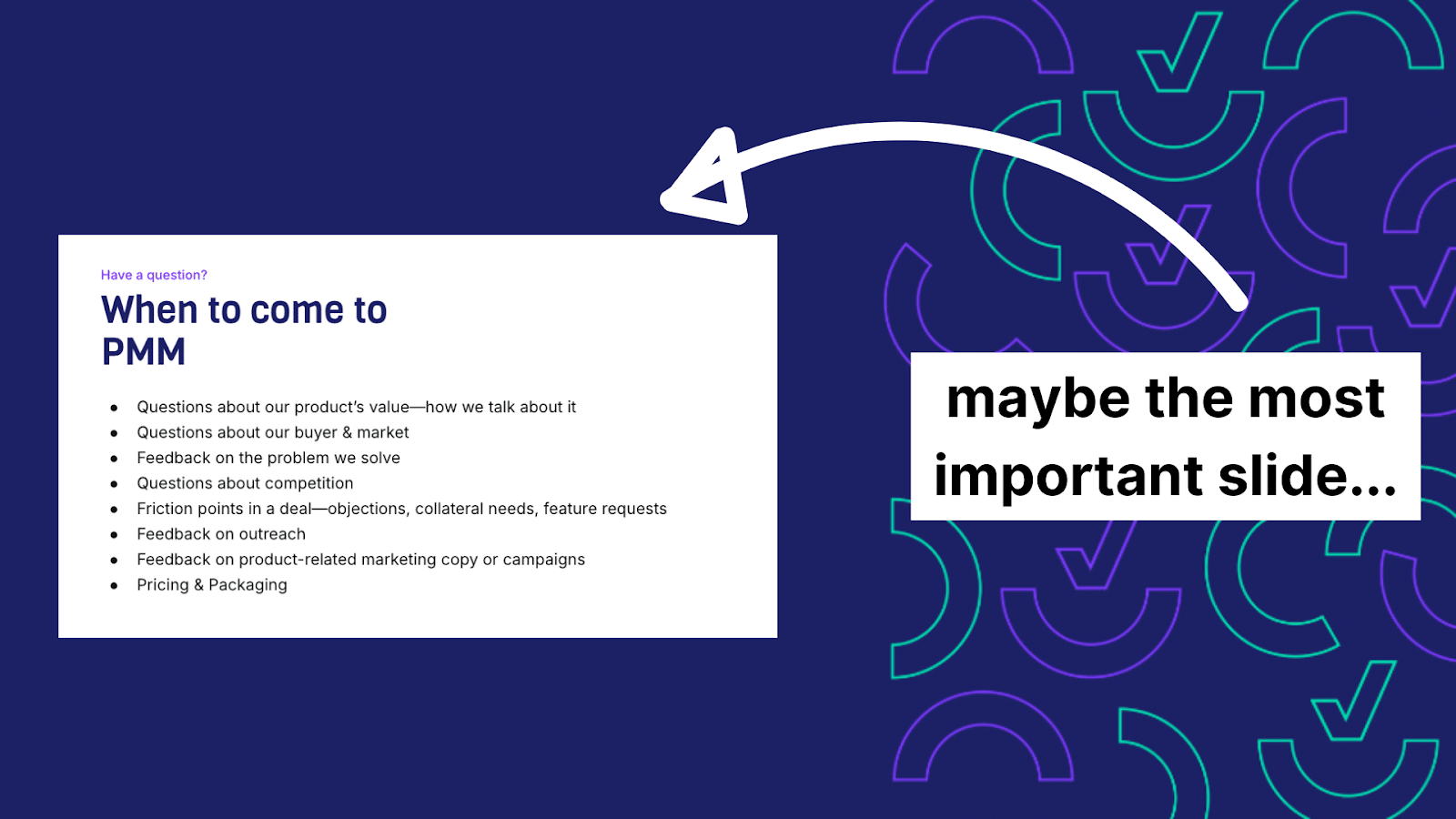
Guiding principles to remember
There are a lot of ideas and moving parts that go into an effective charter. So to wrap the deck walkthrough I want to restate some core truths to remember as you work through your own:
- This is internal selling — First get leadership on board, then the company can follow. You have to earn the right to dictate what product marketing does.
- Context always — Product marketing can’t operate in a vacuum. It’s best to get ahead of and call out the conditions that affect your role, whether it’s the reason for a change or to stay the same.
- Refuse generalities — Any high level idea or jargon must be explained. You saw how I started broad and got very specific to back everything up.
- Bring back up — Just because you’re selling doesn’t mean it has to all come from you. You saw the outside resources I used in my charter, use whatever resources, research, or even respected internal opinions help back up your points. Get rid of the ego in service of the outcome.
When to revisit your charter (and what happened when I did)
Great, you presented your charter. Job done. It will join the documentation graveyard of work completed and never referenced, right alongside your messaging framework (sorry, this one hit close to home).
I’ve failed many times in my career to follow up on something I called a ‘living document’ or ‘source of truth’. We get busy, it’s hard. I get it.
Luckily with a charter there are some built in points you can use to naturally resurface and use it outside of making a new one as your role changes.
My favorite is new hires. Someone joins the sales team, or our marketing team, or there’s a new leadership hire. I hop on to meet them and present the charter to get them up to speed on what I do and how I can help. It’s a great way to help onboard someone and become a known quantity as your team shifts and grows.
You could also force it on a bi-annual or quarterly basis as a part of planning. Either say we’re continuing the charter path, or we’re changing the charter and here’s what’s changing based on priorities.
What happened when I presented my charter again six months later
Around six months into my tenure we hired some new folks. One SDR (hi Liv!) and our content marketer, Jillian. Going into our calls I was curious and a little apprehensive about what I would find. I told them honestly some of this might be out of date and I would clarify as we go.
I was shocked at how little I needed to change. The definitions of product marketing, the focus areas, and the team’s expectations were all still relevant. The projects were outdated only because I had completed almost all of them, which served as a nice progress moment and allowed me to share that work with them naturally.
The charter becoming an informal progress tracker was a nice side benefit. Revisiting it six months later allowed me to reflect on what we’d accomplished and what had shifted. For example, many of the initial projects (like clarifying our buyer’s pain points) were completed, and I could point to tangible results from those efforts. You could use this as a moment to manage up with leadership sharing progress or to update your deck with current projects.
As UserEvidence grows, I know the charter will need updates. New team members, shifting priorities, or even changes in our go-to-market strategy could all necessitate revisions. But I’ve proven mine holds up, I’ve accomplished goals against it, and most importantly built the credibility I need to be effective moving forward. The respect earned by executing against your charter is where your reputation lives.
Final Thoughts
Creating a product marketing charter might seem like a “nice-to-have,” but in a role as misunderstood as ours, it’s necessary. We’re constantly searching for a foothold in strategy, the ear of leadership, and buy-in from our peers. A charter helps you get all three of these.
Plus, it might just save you from spending all day making PDFs.
My goal was to give you a legitimate look at what real product marketing work looks like. For better or worse, you’re seeing what I’ve done in the day-to-day at UserEvidence. I hope you took something away for your own charter.
If you do, let me know. There could be more posts like this in the future. If you disagree with anything in my approach, tell me what you’d change.
Better charters make for happier product marketers, and I just want you to be happy. 💜
Got any questions about my charter or just want to chat PMM? DM me on LinkedIn.






